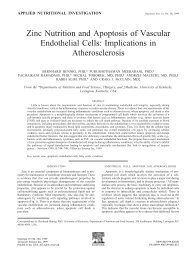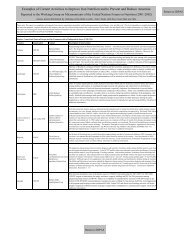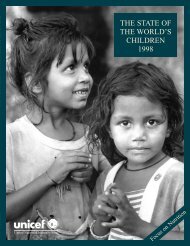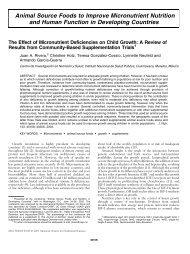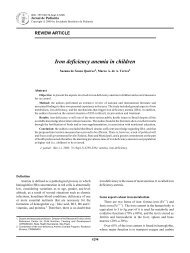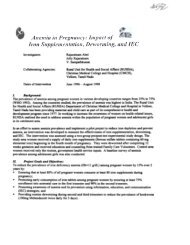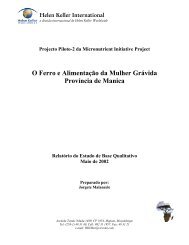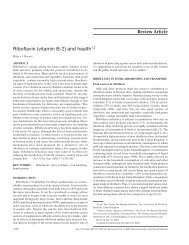WHEAT FLOUR FORTIFICATION WITH IRON - Idpas.org
WHEAT FLOUR FORTIFICATION WITH IRON - Idpas.org
WHEAT FLOUR FORTIFICATION WITH IRON - Idpas.org
You also want an ePaper? Increase the reach of your titles
YUMPU automatically turns print PDFs into web optimized ePapers that Google loves.
I. Introduction<br />
Analyzing the iron content of flour determines whether the required level of iron is present in fortified<br />
flour, which is critical to the success of a flour fortification program. Several analytical methods<br />
are available for determining the level of iron in flour ranging from simple rapid tests to ones<br />
that require sophisticated instruments. The official methods approved by reputed analytical associations,<br />
such as the Association of Official Analytical Chemists (AOAC) and the American Association<br />
of Cereal Chemists (AACC), are generally followed by the flour industry in developed<br />
countries, and in an increasing number of developing countries, in order to meet regulatory and purchasing<br />
quality standards.<br />
This part of the manual provides a comprehensive collection of the analytical techniques available<br />
for determining iron in flour products, including the official methods approved by the AOAC 1 and<br />
AACC 2 and simple assays developed by established research institutions such as INCAP 3 . The<br />
methods are applicable to all iron fortificants and can be used by flour mills, government regulatory<br />
agencies, premix suppliers, or other laboratories involved in food iron analysis. In the following<br />
sections, the principle, advantages, and limitations of qualitative, semi-quantitative, and quantitative<br />
methods are briefly discussed. This information can help to identify and select the most appropriate<br />
assay method for the resources available. This next portion is followed by various appendices,<br />
which include a list that summarizes the main analytical instruments and equipment, their costs, and<br />
supplies (Appendix 3.1) and a list of the major commercial suppliers for laboratory equipment and<br />
chemicals (Appendix 3.2). Appendices 3.3 to 3.10 contain the different iron assay procedures, listed<br />
below along with their applications:<br />
• Qualitative:<br />
Spot test method (AACC 40-40, Appendix 3.3) — Fortified flours<br />
• Semi-quantitative:<br />
Spot test method (INCAP method IV, Appendix 3.4) — Flour and premixes<br />
Colorimetric method (INCAP method V, Appendix 3.5) — Flour, premixes, and other<br />
products<br />
• Quantitative:<br />
Spectrophotometric method (AACC 40-41B, Appendix 3.6; INCAP method VI, Appendix<br />
3.7) — Cereals, cereal products, premixes, various other food products and ingredients<br />
Atomic absorption method (AACC 40-70, Appendix 3.8; AOAC 975.03, Appendix 3.9;<br />
Wet ashing, Appendix 3.10) — Cereals, cereal products, premixes, and other plant foods<br />
All methods have been cited and printed with permission from the respective <strong>org</strong>anizations.<br />
A major concern when conducting iron assays in a laboratory is contamination of non-fortificant iron<br />
from rusted metal fixtures, equipment, and furniture. All analyses must, therefore, be conducted with<br />
utmost care to avoid contamination. This means that all glassware must be soaked in dilute nitric or hydrochloric<br />
acid, thoroughly rinsed with deionized distilled water, and dried in an oven. Moreover, all<br />
reagents must be of analytical grade suited for mineral analyses.<br />
1<br />
AOAC Official Methods of Analysis (2000). 17 th edition. Association of Official Analytical Chemists<br />
International, Arlington, Virginia, USA.<br />
2<br />
Approved methods of the American Association of Cereal Chemists (2000). 10 th edition. American<br />
Association of Cereal Chemists, Inc., Minnesota, USA.<br />
3<br />
Methods for iron determination were obtained through personal communication with Dr. Omar Dary at the<br />
Institute of Nutrition of Central America and Panama, Guatemala City, Guatemala.<br />
1




